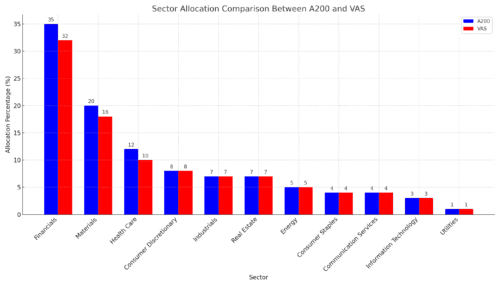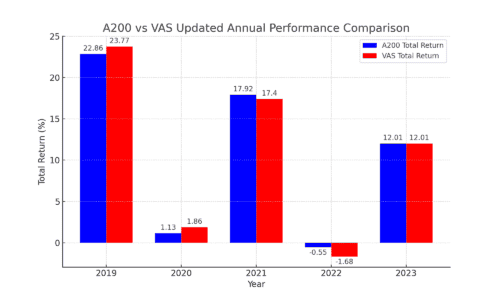
Exchange-traded funds (ETFs) are a popular choice for investors seeking to diversify their portfolios without the complexity of managing individual stocks. In Australia, two major ETFs stand out: BetaShares Australia 200 ETF (A200) and Vanguard Australian Shares ETF (VAS). In this comprehensive guide, we’ll dive deep into the features, performance, and key differences between these two leading Australian share ETFs (A200 vs VAS) to help you make an informed investment decision.
Understanding ETFs and Their Benefits
Before we compare the A200 and VAS ETFs, let’s quickly recap why investors are drawn to these types of investment products.
An ETF is a pooled investment fund that trades on a stock exchange, just like individual company shares. ETFs provide investors with a simple and cost-effective way to gain exposure to a diversified basket of securities, such as stocks, bonds, or commodities.
When it comes to investing in the Australian share market, ETFs offer several key advantages:
- Diversification: By investing in an ETF, you gain exposure to a broad range of Australian companies, reducing your risk compared to holding individual stocks.
- Low Costs: ETFs generally have lower management fees compared to actively managed funds, allowing you to keep more of your investment returns.
- Ease of Trading: You can buy and sell ETF units on the Australian Securities Exchange (ASX) during regular trading hours, just like buying and selling shares.
- Transparency: ETFs provide clear and regular updates on their holdings and performance, so you always know what you’re invested in.
Now that we’ve covered the basics let’s dive into the details of the A200 and VAS ETFs.
BetaShares Australia 200 ETF (A200): A Closer Look
The BetaShares Australia 200 ETF (ASX: A200) is designed to track the performance of the S&P/ASX 200 Index, which consists of the 200 largest companies listed on the Australian Securities Exchange (ASX).
Key Features of the A200 ETF:
- Index Tracked: S&P/ASX 200 Index
- Number of Holdings: Approximately 200 companies
- Management Fee: 0.04% per year
- Dividend Distributions: Paid quarterly
One of the standout features of the A200 ETF is its extremely low management fee, which is just 0.04% per year. This makes it one of the cheapest ways for investors to gain broad exposure to the Australian share market.
Vanguard Australian Shares ETF (VAS): An Overview
The Vanguard Australian Shares ETF (ASX: VAS) tracks the performance of the S&P/ASX 300 Index, which includes the 300 largest companies listed on the ASX.
Key Features of the VAS ETF:
- Index Tracked: S&P/ASX 300 Index
- Number of Holdings: Approximately 300 companies
- Management Fee: 0.07% per year
- Dividend Distributions: Paid quarterly
While the VAS ETF has a slightly higher management fee of 0.07% compared to the A200, it provides investors with exposure to a broader range of Australian companies through the S&P/ASX 300 Index.
A200 vs VAS: Head-to-Head Comparison
Now, let’s take a closer look at how the A200 and VAS ETFs stack up against each other.
| Feature | A200 | VAS |
|---|---|---|
| Index Tracked | S&P/ASX 200 | S&P/ASX 300 |
| Number of Holdings | ~200 | ~300 |
| Management Fee | 0.04% | 0.07% |
| Dividend Yield (12-month) | ~4.5% | ~4% |
| 5-Year Average Annual Return | 9.12% | 9.05% |
As you can see, the main differences between the two ETFs lie in the breadth of their underlying indices and the slight variation in management fees.
Sector Allocation Comparison
One way to assess the diversification of the A200 and VAS ETFs is to look at their sector allocations. The charts below show the sector breakdowns for each fund:

Both ETFs have a significant allocation to the Financials and Materials sectors, which is typical of the Australian share market. However, the VAS ETF provides slightly more exposure to sectors like Healthcare, Industrials, and Consumer Discretionary due to its broader index.
Top Holdings Comparison
Another factor to consider is the top holdings of each ETF. While the underlying indices have some differences, the top companies held by the A200 and VAS ETFs are quite similar:
| A200 Top Holdings | Weight | VAS Top Holdings | Weight |
|---|---|---|---|
| BHP Group Ltd. | 9.80% | BHP Group Ltd. | 9.44% |
| Commonwealth Bank of Australia | 8.50% | Commonwealth Bank of Australia | 8.27% |
| CSL Ltd. | 5.90% | CSL Ltd. | 5.86% |
| National Australia Bank Ltd. | 4.60% | National Australia Bank Ltd. | 4.49% |
| Westpac Banking Corp. | 4.00% | Westpac Banking Corp. | 3.92% |
As you can see, the top holdings are dominated by well-known Australian companies across the Financials, Materials, and Healthcare sectors.

A200 vs VAS: Performance Comparison
Now, let’s take a closer look at the historical performance of the A200 and VAS ETFs.
5-Year Performance Comparison Over the past 5 years, the A200 ETF has delivered an average annual return of 9.12%, slightly outperforming the VAS ETF’s 9.05% average annual return. Looking at the annual performance of the A200 and VAS ETFs, we can see that they have delivered very similar results, with the two funds performing within a percentage point of each other in most years:

As you can see, the two ETFs have tracked each other quite closely, with the A200 edging out the VAS in terms of total returns.
Year | A200 Total Return | VAS Total Return |
|---|---|---|
| 2023 | 12.01% | 12.01% |
| 2022 | -0.55% | -1.68% |
| 2021 | 17.92% | 17.40% |
| 2020 | 1.13% | 1.86% |
| 2019 | 22.86% | 23.77% |
This consistent performance demonstrates the similarities between the two ETFs and the broader Australian share market.
Dividend Distributions
Both the A200 and VAS ETFs pay quarterly dividends to investors, derived from the dividends received from the underlying companies in their portfolios.
A200 Dividend History The A200 ETF has a history of consistent dividend payments, with a 12-month dividend yield of around 4.5% as of the latest distribution:
| Ex-Date | Distribution Per Unit | Annual Distribution Return |
|---|---|---|
| 2-Jan-24 | $1.05 | 4.38% |
| 2-Oct-23 | $1.71 | 4.45% |
| 3-Jul-23 | $0.80 | 4.87% |
| 3-Apr-23 | $1.15 | 6.65% |
VAS Dividend History
The VAS ETF has also maintained a steady stream of dividend payments, with a 12-month dividend yield around 4% as of the latest distribution.
The Challenges in Choosing Between A200 and VAS
Both the A200 and VAS ETFs offer investors low-cost, diversified exposure to the Australian share market. So, what are the key factors to consider when deciding between the two?
Management Fees One of the primary differences between the A200 and VAS ETFs is their management fees. The A200 ETF has a slight edge with a management fee of just 0.04% per year, while the VAS ETF charges 0.07% per year.
For investors focused on minimizing costs, the A200 ETF may be the more appealing option. However, the difference in fees is relatively small, and both ETFs are still significantly cheaper than many actively managed funds.
Index Breadth The VAS ETF tracks the S&P/ASX 300 Index, which provides exposure to a broader range of Australian companies compared to the S&P/ASX 200 Index tracked by the A200 ETF.
Investors seeking a more comprehensive representation of the Australian share market may prefer the VAS ETF’s 300-company portfolio. However, the top holdings of the two ETFs are quite similar, so the difference in diversification may not be a deal-breaker for many investors.
Performance and Dividends As we’ve seen, the A200 and VAS ETFs have delivered very similar long-term performance, with the A200 edging out the VAS slightly in terms of average annual returns.
Similarly, both ETFs have maintained steady dividend payments, with the A200 ETF offering a slightly higher 12-month dividend yield of around 4.5% compared to the VAS ETF’s 4%.
Ultimately, the performance and dividend differences between the two ETFs are relatively minor, and investors may need to weigh other factors to determine the better fit for their investment portfolio.
Which ETF is Right for You?
When deciding between the A200 and VAS ETFs, consider the following factors:
- Investment Objective: If you’re seeking the lowest possible management fees, the A200 ETF may be the better choice. However, if you prefer broader diversification, the VAS ETF’s 300-company portfolio may be more appealing.
- Risk Tolerance: Both ETFs provide exposure to the broader Australian share market, so the risk profiles are relatively similar. However, the VAS ETF’s slightly more diversified portfolio may be preferable for investors with a lower risk appetite.
- Investment Time Horizon: As long-term, buy-and-hold investments, both the A200 and VAS ETFs are well-suited for investors with a multi-year investment horizon.
- Personal Preference: With the performance and dividend profiles being quite close, your final decision may come down to personal preference and how the ETFs fit into your overall investment strategy.
Ultimately, both the A200 and VAS ETFs are high-quality, low-cost options for gaining exposure to the Australian share market. Carefully consider your investment goals, risk tolerance, and portfolio needs to determine which one aligns best with your financial objectives.
FAQ’s
What’s the difference between the A200 and VAS ETFs?
The main differences between the A200 and VAS ETFs are:
1. Index Tracked: A200 tracks the S&P/ASX 200 index, while VAS tracks the S&P/ASX 300 index.
2. Number of Holdings: A200 holds around 200 companies, while VAS holds around 300 companies.
3. Management Fee: A200 has a lower management fee of 0.04% compared to VAS at 0.07%.
Which ETF (A200 vs VAS) has a higher dividend yield?
The A200 ETF has historically offered a slightly higher dividend yield compared to VAS. As of the latest distributions, the 12-month dividend yield for A200 was around 4.5%, while VAS was around 4%.
How have the A200 and VAS ETFs performed over the long term?
Both ETFs have delivered very similar long-term performance. Over the past 5 years, the A200 ETF has had a slightly higher average annual return of 9.12% compared to VAS at 9.05%.
What are the top holdings in the A200 and VAS ETFs?
The top holdings in both ETFs are quite similar, dominated by large Australian companies like BHP Group, Commonwealth Bank, CSL, and Westpac. The weightings of the top holdings are also comparable between the two funds.
Which ETF (A200 vs VAS) provides broader diversification?
The VAS ETF, with its approximately 300 holdings, provides slightly broader diversification compared to the 200 holdings in the A200 ETF. However, the sector allocations and top holdings of the two funds are quite similar.
Which ETF (A200 vs VAS) has a lower management fee?
The A200 ETF has a lower management fee of 0.04% per year compared to the 0.07% fee charged by the VAS ETF.
Which ETF (VAS vs A200) is the better investment choice?
Both the A200 and VAS ETFs are high-quality, low-cost options for gaining exposure to the Australian share market. The choice between the two will depend on your investment objectives, risk tolerance, and personal preferences. Factors to consider include management fees, index breadth, and your overall portfolio diversification needs.
Expand Your Financial Knowledge: Visit our Personal Finance section for essential tips, delve into Property Investing for the latest market insights, or explore our comprehensive Resources for educational articles and tools. If you’re interested in the stock market, our Shares & ETFs section offers a range of options to suit your investment goals. Dive into these areas to enhance your financial understanding and decision-making.
Disclaimer
Not a Licensed Financial Advisor
The information and insights provided in this document are intended solely for educational and informational purposes. It’s imperative to understand that I am not a licensed financial advisor, tax expert, or investment strategist. The contents herein are crafted to offer a general overview and should not be construed as personalized financial advice.
Affiliate Disclosure: Some of the links on this blog may be affiliate links. This means if you click on the link and purchase a product or service, I may receive a commission at no additional cost to you. I only recommend products or services that I believe in, and that may be helpful to my readers.
Before making any financial decisions or embarking on investment ventures, it’s crucial to consult with a professional financial advisor or a certified tax consultant who is well-equipped to understand your unique financial landscape. Engaging with a licensed professional ensures that the advice you receive is tailored to your specific financial goals, risk tolerance, and tax obligations, adhering to the compliance and guidelines established by regulatory authorities, including the Australian Taxation Office (ATO) and other relevant bodies.
Financial markets are complex and dynamic and involve various degrees of risk. Therefore, thorough due diligence and professional guidance are essential to navigate these waters effectively. This content does not represent the opinions or endorsements of any financial institutions or regulatory agencies. Remember, the responsibility for financial decisions lies with the individual, and seeking qualified advice is the best step towards informed decision-making and achieving financial objectives.
